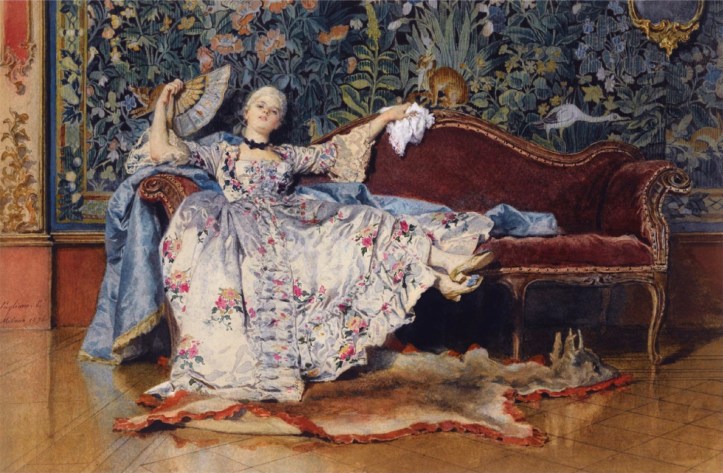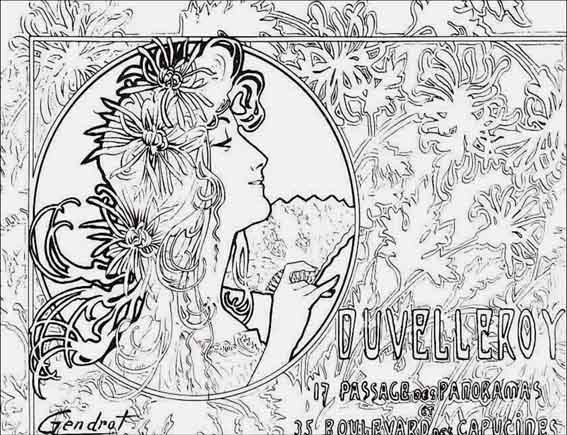
Before the Victorian era, fans were prohibitively expensive and were most commonly used in the royal courts of Denmark and France. English women wanting them in the eighteenth and early nineteenth centuries were obliged to buy them imported. Fortunately for the thriftier ladies of fashion, the mass production of the Industrial Revolution soon made them available to the wider public.
The popularity of fans during the Victorian period was due in no small part to French fan-maker, Duvelleroy. When his first London shop opened on Regent Street in 1860, sales were propelled by the shop’s proprietor, Duvelleroy’s son, Jules, who encouraged the development of the language of fans through guides he published in leaflets. Some of these signals had been used before, but many of them he invented.
The “language” was a set of signals ladies could give with the fans to communicate with their suitors without speaking to them. While it is true that certain signals had been in use in the royal courts of Europe before Jules Duvelleroy captured the imagination of his shoppers, the much expanded set of signals he fostered started out as little more than a clever marketing gimmick. It was romantic, flirtatious, and ladies loved it.
The next time you’re at a ball and you would like to alert your chaperone that you need to use the facilities without accidentally becoming engaged, here’s a helpful guide to some of the most common fan signals:
Yes: Touch your right cheek with your fan and leave it there.
No: Touch your left cheek with your fan and leave it there.
I’m married: Fan yourself slowly.
I’m engaged: Fan yourself quickly.
I desire to be acquainted with you: Place the fan in your left hand in front of your face.
Follow me: Place the fan in your right hand in front of your face.
Wait for me: Open your fan wide.
You have won my affection: Place the fan over your heart.
Do you love me?: Present the fan closed to them.
I love you: Draw the fan across your cheek.
Kiss me: Press a half-open fan to your lips.
I love someone else: Twirl the fan in your right hand.
We are being watched: Twirl the fan in your left hand.
You are cruel: Open and close the fan several times.
I hate you: Draw the fan through your hand.
Forgive me: Hold the fan open in both hands.
I am sorry: Draw the fan across your eyes.
Go away: Hold the fan over your left ear.
Do not be so imprudent: Make “threatening movements” with closed fan.
Do not betray our secret: Cover left ear with fan.
We will be friends: Drop the fan.
It is unclear how many ladies actually used fan signals to successfully communicate with their suitors. Even in this short list, there is ample opportunity for misunderstanding, and one can only guess how the gentlemen were expected to respond without holding fans of their own. We can only hope those not blessed with an expressive gaze were able to communicate by blinking in code or perhaps with rapid eyebrows movements! It’s easy to imagine a young suitor, totally baffled by the curious fan movements of his beloved, misunderstanding or giving up completely. Heaven help the poor lady who drops the thing or itches her ear with it and ruins her chances with someone by accident.

In spite of the potential for misunderstanding, the popularity of fans endured throughout the nineteenth century. Beautiful fans were status symbols and they were an essential accessory for stuffy halls and ballrooms. Duvelleroy enjoyed another surge in popularity when they later embraced art nouveau with new shapes and hand painted designs.
Duvelleroy is still open today, in fact, and you can read about their history and see some of their stunning fans from the last two hundred years here.
Jessica Cale
Sources
MacColl, Gail and McD. Wallace, Carol. To Marry an English Lord.
Paterson, Michael. Life in Victorian Britain.
Willett Cunnington, C. English Women’s Clothing in the Nineteenth Century.
Duvelleroy, History.

LOL It just reminds me of the Horrible History comedy show. All the confusion and misunderstandings. Like what if I was super hot and needed to just fan myself, or more like swat away the stench in the room?
But, my this was very sly~ And flowers were of good use too. What do we use this generation? Abbreviations! Or emogies.
LikeLike
Absolutely! I think it would be hard to carry out a conversation (even a short one) with any subtlety. Plus, several other people were likely to understand what the signals meant if they were paying attention. Maybe not the most effective way to flirt! It’s funny to imagine that maybe two hundred years from now, people will be trying to decipher our emojis like hieroglyphics! LOL
LikeLiked by 1 person
Hi Jessica, LOVE this post. Must share!
Kimberly Keyes
https://facebook.com/kimberly.keyes.romance
LikeLike
Thanks very much, Kimberly! 🙂
LikeLike
[…] On Jessica Cale’s blog Dirty, Sexy History she’s spilling the secret language of fans in Victorian England. Most amusingly, the whole thing was mostly a sales gimmick. And such a successful one. Read on for fun. Click here for Dirty, Sexy History post “Flirtation, Victorian Style: The Secret Language of F… […]
LikeLike
[…] Source: Flirtation, Victorian Style: The Secret Language of Fans […]
LikeLike
Hahaha I would make a huge mess of this!
LikeLike
[…] The Language of the Fan https://dirtysexyhistory.com/2016/08/04/flirtation-victorian-style-the-secret-language-of-fans/ […]
LikeLike